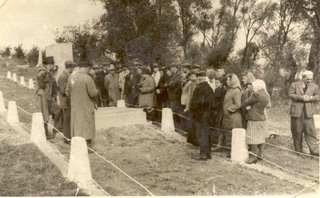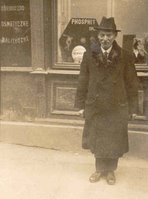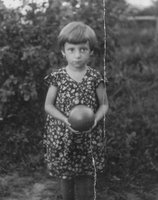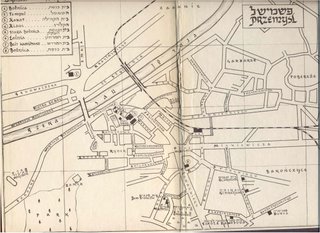© David R. Semmel 2003
Fannie Metzger, my mom’s mother and my grandmother was one of 9 children from the town of Przemysl , in the foothills of the Carpathian Mountains in southeastern Poland . We knew that one of her brothers, Isaac, had survived the war, returned, remarried and later died in the early ‘70s. It was our hope to locate his adopted son, who we believed to be named Jerzy.
May 8, 2003 started early at our hotel in the Rzeszow, about 50km up the main highway from Przemysl, over coffee and cold cuts with my parents, Mel and Dorothy, our driver, Jan, and our guide, Kris. Rzeszow , Kris noted, was once known to Poles, pejoratively, as “Mojzeszow” (in English ‘Mosestown), owing its once large Hasidic population. Today it is a dreary industrial city with little outward charm.
To simply label Kris Malczewski as a tour guide doesn’t even begin to capture the true meaning of his work. His formula is equal parts detective, linguist, psychologist, anthropologist, salesman and entrepreneur, sprinkled liberally with a frenetic activity level, a compulsive drive, and a likeable country boy personality, and all topped off with a surfeit of raw chutzpa. None of the wonderful things that transpired this day in Przemysl could have been possible without him.
Kris, David, Jan, Dorothy and Mel
If you don't look too closely, the approach to Przemysl from the north looks like a scene out of rural Wisconsin with gently rolling hills holding many small farms. The fields are long narrow rectangles, radiating out from the road at right angles. On closer inspection you find a refreshing variety of crops, from grains to berries, potatoes and vegetables. The tractors are Soviet vintage and you still see the occasional horse cart. Przemysl occupies a ‘V’ shaped valley with city on both slopes, with the swift and rocky San River at the crux. Because of the hills the city occupies, Przemysl has almost no right angle intersections, and it’s winding maze of streets and alleys give it something close to the feel of an Umbrian ‘hilltop’ town.
Przemysl
Our first stop was Smolki Street to see Rozia Felner who Kris knew from his past research work. She is one of the very few Jews who survived the war and resettled in Przemysl. Perhaps she knew of our Isaac, who had also survived and returned to the city. We pulled up to her street, across from the 4 story apartment building where she lived. Kris, always thinking and working, ran to a corner store and bought her a box of chocolates.
The building, like almost all the buildings in this part of the world, was covered in a grey patina, laid down from years of soot from the coal stoves which heat each apartment. While it lacked some features we take for granted like screens and central heat, it was, by Polish standards, solidly middle class. We ascended the 4 flights of stairs to Rozia’s, past buckets of coal and kindling on each story’s landing. She was expecting us as Kris had phoned her the prior evening. She lived alone in the modest but quite comfortable flat. After she proudly served us coffee and cakes, we got down to business. Our guide Kris is, in addition to his many other talents, a gifted translator capable of going from Polish to English as sentences are being uttered. Soon after we began, she looked at us and said that she knew where our relative was buried, next to her husband in the Jewish cemetery, and that his wife, Aniela, was still alive but quite infirmed. It’s hard to convey the sledge hammers impact of hearing, first hand, that a previously unnamed and unknown wife of an almost mythical uncle was actually still alive.

Rozia at the Cemetery Gate
At 88 Rozia has seen and lived through more than anyone you’re ever likely to meet. Her eyes are foggy and one is a bit crossed but her mind is still razor sharp and her voice clear and forceful. She easily wields the authority of a family matriarch, at one point looking at my stomach and suggesting that I should try to emulate the more slender figure of my mother, rather than that of my father. Said as only an authentic Jewish mother could!
In a touching moment, when we had asked about her life, she looked at Kris and said but a few words which he did not translate for us. Later we learned that she had told him she could not bear to recall too much of her life as it was just too hard to deal with and for fear of kindling nightmares. A few days later in Krakow I bought a book that contained short life stories written by survivors from Przemysl. Rozia was one of the authors. She gives a brief but gut-wrenching account of her ordeal and improbable survival amid unspeakable horrors. In closing, she offers: “I am many times lonely now, and I don’t like to think very much about the war and the losses of the Jewish people.”
She knew of a man who would know how to find Aniela. She suggested, no, more accurately she told us, that we would all go to see him, stopping at the cemetery on the way. We descended the 4 flights, got into the car, and drove off on a mission to find our newly named relation.
By European standards, the Jewish cemetery in Przemysl is in pretty good shape. It has a gate and a fence and well over half of the stones are still in place. It’s not so much a cemetery in the American sense of neat rows and columns, it’s more of a wild forest with stones scattered among the trees and underbrush. The very few post war stones are in front with the vast majority of older ones set back into the encroaching forest. As you walk deeper into the forest, you walk further back in time. After 50 meters or so, all Latin script disappears into Hebrew. There is a simple but poignant memorial stone dedicated to the 4,000 or so Przemysl Jews murdered in the Shoah. While it is not well groomed, I wouldn’t say that it lacks for dignity. There is a fusion of nature and spirit in this place that is hard to describe yet almost overwhelmingly palpable. This is an intensely spiritual place. Rozia asked me to light two candles she had brought for her husband’s grave, a duty I was honored to perform.

Jewish Cemetery
With only a dozen or so post-war stones to look at, all crowded near the cemetery entrance, it took but a moment to locate the grave of one Edward Metzger. Our initial confusion over the name was quickly explained by Rozia, who knew our Isaac by his ‘street’ name, Edward. Given that he had married a Catholic woman, Aniela, and with the political climate as it was in communist Poland , it is not surprising that he adopted a more Christian name.
Later, we piled back into the van to find Joachim, a friend of Rozia’s who she thought could help us. A former storekeeper, now a retired pensioner, we found him at his apartment. It’s a good thing we had a van because before long Jochiam was driving with us to show us the area he thought she lived in. After dropping Rozia and Joachim off, we arrived at an apartment block. As it turned out, this was to be a dead end. Kris stopped all sorts of people on the street, asking everyone and anyone if they know of an old woman named Aniela who lived in this block. It was fascinating to interact with a wide range of locals; kids, teens, drunks, young and old couples. Finally, three older women who just looked like they knew everything that went on it this block told us she didn’t live there. We believed them.
Not even remotely ready to quit, Kris decided to visit the city hall. The records department was on the 3rd floor, so up we climbed. The building is a nondescript box, modern in the early 60’s manner. We entered the records division and were promptly ushered next door into a room filled floor to ceiling with metal file boxes. Kris, who had been working overtime charming the middle aged lady clerks in Polish started probing for data with one of the women who appeared to be in charge and manned the computer console. The computer was an index to the records and looked to be from the age of ‘pong’. Unfortunately, we seemed to be striking out on searches for any Metzger. In modern Poland there is a privacy law that seals any and all state records that are less than 100 years old so, technically, what we were asking for was illegal. Some combination of Kris’ charm, his name dropping of the town mayor and what I believe to have been genuine kindness and unspoken understanding with the clerks all conspired to rally the office to our aid.
Just as we were ready to give up and leave, one of the women comes through a doorway from another archive waving a 5x7 card which, with little fanfare, was deposited on the Formica counter before us. And there it all was. Like a mini Rosetta stone, this card laid out, in longhand, the life of one Aniela Tyczynska of Tarnowskiego Street . She was born July 26, ’22 as Aniela Binczak. Her first married name was Wojtowicz, which is also the name of her son Jerzy, born June 11, ‘41 . After the war she married Isaac Metzger, who’s street name was Edward. He died in 1971 after which she married a third time with the name Tyczynska. Kris called the apartment on his cell and quickly arranged for us to meet.
Her apartment has a small vestibule that opens into a fairly spacious eat-in kitchen. All of the appliances are small by our standards and electric. She showed us into the living/dining room and sat us at a small table in the room’s center. Her balcony doors were open and she had a small flower garden in pots growing. The room itself, like all apartments we saw in Poland , was muted, lit by a single 25 watt bulb. On the walls were photos of her children and grand children. Particularly striking was a wedding portrait of her son Jerzy and his beautiful wife Anna, a dead ringer for a young Kim Novak. While we know that Aniela is not Jewish, curiously, there were few if any obvious Catholic symbols to be found in her apartment.
Aniela
Aniela began to talk in Polish, translated as she spoke by Kris. Isaac didn’t follow his siblings to America because he had been drafted into the Army in the 30’. On release, he married and unknown woman, c. 1938. She knew him pre-war because her family, the Binczak’s and the Metzger family were neighbors and friends, living on ‘ Kopernica Street ’. Isaac left voluntarily by train for Russia in ’39 with a group of other Jewish men, presumably to fight on the Soviet side against the Nazis. (In 1939 Przemysl was the border with one bank of the San River in Russia and the other in Germany . When hostilities broke out, many Jews, many of whom were also ardent Socialists or Communists, chose to go over the Russian side to fight.) Aniela’s family receive messages from him, indicating that he first went to Lemberg ( L’vov) then on to Sambor.
He returned to Przemysl in ’44 as a corporal in a Polish Army unit formed in Russia and fighting along side the Red Army. On return, he found his wife gone, presumably murdered in the holocaust. Aniela’s family hid his identity cards to protect him from the partisans (?). One theory is that he was hiding the fact that he was Jewish since in 1946 there was a vicious pogrom in many parts of Poland and the Polish Army units formed in Soviet Russia contained a disproportionately high percentage of Jews. He and Aniela married soon after the war, her first husband having died, likely as a soldier.
She remembers visits post-war from many of Isaac’s Polish Army comrades who later immigrated to Israel . He was a ‘tinner’ or a metal worker and a member of the Communist party. He was also a member of the ‘nationalist’ group (?). Later, he became a worker at a library/bookstore on the ground floor below the very apartment we were in. There is still a sign at the entry way for this long since shuttered store. He received money and had much contact with the Israeli embassy. Perhaps this was German war reparations which were officially shunned by the Communist Poles?
He was jailed in the late ’50 for something to do with mis-appropriated clothing and repatriated workers from the east. Aniela downplayed the entire episode, saying she hired a lawyer and he spent only a short time in jail. We suspect that there is much more to this tale, and a significant political angle, than she was willing to tell us.
She remembered receiving care packages from the Metzger family, especially from my grandmother Fannie, or Fania to her, who could read and write in Polish. She also recalled fondly visits from Edward’s American relatives; his nephew, Bernard Flamenbaum and wife Barbara during the late 50's, and a visit from his sister-in law, Molly Metzger on her way to Moscow in the 60's.

At one point there was an enigmatic exchange about Edward’s gravestone and her feeling that his burial site needed to be better taken care of. Coming on the heels of her remembrance of the care packages the family sent for years, were we to interpret this as a request for financial assistance? In subsequent discussion with Kris and other Poles, we concluded that it is more in keeping with a tradition of self deprecation than an overt request for money. But its not at all clear and in the end our conclusion rests almost completely on the nuance of translation that Kris chose to relate to us. Finally, she recalled that the Metzger’s had a family bakery on ‘ Ratashova Street ’ until 1939.
We then heard all about her family. Recently retired Jerzy and wife now live in Stalowa Wola, a city about 100km to the north. Their children are Kasia or Katarzyna (m. Leszek Warchol – both doctors) and Marta (m. Darek Banka – both teachers). She has several grandchildren and beamed as she proudly showed off snapshots. While not blood relations, she was clear and emphatic on how close Isaac/Edward and Jerzy were up to his death and how he was grandfather to the children.
Aniela has advanced Parkinson’s and tires easily. The 90 minutes we talked had taken its toll on her, both physically and emotionally. But this is a strong and proud woman who clearly enjoyed our visit almost as much as we treasured meeting her. As we left, we exchanged the hugs of a family.
Labels: Metzger, Rozia Felner
 Did you know that there is a ski hill within the city limits of Przemysl? I had no idea. Tells you something about what the winters must be like... cold!
Did you know that there is a ski hill within the city limits of Przemysl? I had no idea. Tells you something about what the winters must be like... cold! Did you know that there is a ski hill within the city limits of Przemysl? I had no idea. Tells you something about what the winters must be like... cold!
Did you know that there is a ski hill within the city limits of Przemysl? I had no idea. Tells you something about what the winters must be like... cold!
 Two German officers in Przemysl, two righteous among the nations.
Two German officers in Przemysl, two righteous among the nations. BAD AROLSEN, Germany -- The 21-year-old Russian sat before a clerk of the U.S. Army judge advocate's office, describing the furnaces at Auschwitz, the Nazi death camp where he had been a prisoner until a few weeks previously.
 I was looking through the pictures in the Przemysl Yizkor (holocaust remembrance written by survivors in Hebrew and Yiddish) book the other day when I came across a photo that caught my eye. After a few moments racking my brain, it dawned on me; this is the same photo that my grandmother Fannie had in her album - the one that no one in the family could identify. A funeral, but for who? And where?
I was looking through the pictures in the Przemysl Yizkor (holocaust remembrance written by survivors in Hebrew and Yiddish) book the other day when I came across a photo that caught my eye. After a few moments racking my brain, it dawned on me; this is the same photo that my grandmother Fannie had in her album - the one that no one in the family could identify. A funeral, but for who? And where?
 Isaac (Edward) who did return to Przemysl from Russia after the war only to find his wife and four children gone, but that’s another story altogether.
Isaac (Edward) who did return to Przemysl from Russia after the war only to find his wife and four children gone, but that’s another story altogether.Six years ago, Pawel made a discovery that turned his life upside down - he found out that he was Jewish. His parents had turned their back on Jewish life and they had never told him about his background.
 The following information is from the indispensable ShtetLinks Przemysl web site:
The following information is from the indispensable ShtetLinks Przemysl web site: letters and photos she left me was a picture of a five or six year old girl holding a ball. On the back of the photo was written To my daughter Cilli (my mother’s name) here is your sister Dvora, Przemysl. It seemed very strange to me because I knew that my grandfather Chaim Glaser, who got divorced from my grandmother in the early twenties, lived in Vienna had only three children: my mother and her two brothers.
letters and photos she left me was a picture of a five or six year old girl holding a ball. On the back of the photo was written To my daughter Cilli (my mother’s name) here is your sister Dvora, Przemysl. It seemed very strange to me because I knew that my grandfather Chaim Glaser, who got divorced from my grandmother in the early twenties, lived in Vienna had only three children: my mother and her two brothers. During my research which started about fifteen years ago I found out that my grandfather, a shoemaker, married Rachla Stolzberg in 1926 and a year later they had a daughter - Dvora. The Przemysl archives confirmed all of this when I received from them the marriage certificate and the birth certificate of Dvora. I found a relative of Rachla who told me that she passed away a few years after her marriage that my grandfather's financial situation became so bad that he was forced to put Dvora in an orphanage. That was all I found out. People from all over the world tried to help me find out what became of Dvora, but with no success.
During my research which started about fifteen years ago I found out that my grandfather, a shoemaker, married Rachla Stolzberg in 1926 and a year later they had a daughter - Dvora. The Przemysl archives confirmed all of this when I received from them the marriage certificate and the birth certificate of Dvora. I found a relative of Rachla who told me that she passed away a few years after her marriage that my grandfather's financial situation became so bad that he was forced to put Dvora in an orphanage. That was all I found out. People from all over the world tried to help me find out what became of Dvora, but with no success. One of them was Rozia Felner, whose address I got from Dr. Hartman. I used to send her money and parcels of Israeli food every Rosh Hashanah and Pesach. She always thanked me in Polish and added a few Hebrew words she remembered from the days she went to a Jewish school in Przemysl. This year she didn’t response, now I know why.
One of them was Rozia Felner, whose address I got from Dr. Hartman. I used to send her money and parcels of Israeli food every Rosh Hashanah and Pesach. She always thanked me in Polish and added a few Hebrew words she remembered from the days she went to a Jewish school in Przemysl. This year she didn’t response, now I know why. This map is from the inside cover of the Przemysl Yizkor book.
This map is from the inside cover of the Przemysl Yizkor book. Please, please, please contribute - just email me your photos, comments or essays and I will post them to the site. Email me here
Please, please, please contribute - just email me your photos, comments or essays and I will post them to the site. Email me here Click here: Remembering the Jews of Przemysl
Click here: Remembering the Jews of Przemysl
 Rozia Felner died on October 21 and was buried next to her husband in the cemetery on Slowackiego Street in Przemysl, Poland.
Rozia Felner died on October 21 and was buried next to her husband in the cemetery on Slowackiego Street in Przemysl, Poland.